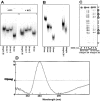Formation and properties of hairpin and tetraplex structures of guanine-rich regulatory sequences of muscle-specific genes
- PMID: 15908587
- PMCID: PMC1133794
- DOI: 10.1093/nar/gki606
Formation and properties of hairpin and tetraplex structures of guanine-rich regulatory sequences of muscle-specific genes
Abstract
Clustered guanine residues in DNA readily generate hairpin or a variety of tetrahelical structures. The myogenic determination protein MyoD was reported to bind to a tetrahelical structure of guanine-rich enhancer sequence of muscle creatine kinase (MCK) more tightly than to its target E-box motif [K. Walsh and A. Gualberto (1992) J. Biol. Chem., 267, 13714-13718], suggesting that tetraplex structures of regulatory sequences of muscle-specific genes could contribute to transcriptional regulation. In the current study we show that promoter or enhancer sequences of various muscle-specific genes display a disproportionately high incidence of guanine clusters. The sequences derived from the guanine-rich promoter or enhancer regions of three muscle-specific genes, human sarcomeric mitochondrial creatine kinase (sMtCK), mouse MCK and alpha7 integrin formed diverse secondary structures. The sMtCK sequence folded into a hairpin structure; the alpha7 integrin oligonucleotide generated a unimolecular tetraplex; and sequences from all three genes associated to generate bimolecular tetraplexes. Furthermore, two neighboring non-contiguous guanine-rich tracts in the alpha7 integrin promoter region also paired to form a tetraplex structure. We also show that homodimeric MyoD bound bimolecular tetraplex structures of muscle-specific regulatory sequences more efficiently than its target E-box motif. These results are consistent with a role of tetrahelical structures of DNA in the regulation of muscle-specific gene expression.
Figures







Similar articles
-
MyoD uses overlapping but distinct elements to bind E-box and tetraplex structures of regulatory sequences of muscle-specific genes.Nucleic Acids Res. 2007;35(21):7087-95. doi: 10.1093/nar/gkm746. Epub 2007 Oct 16. Nucleic Acids Res. 2007. PMID: 17942416 Free PMC article.
-
Homodimeric MyoD preferentially binds tetraplex structures of regulatory sequences of muscle-specific genes.J Biol Chem. 2005 Jul 22;280(29):26805-12. doi: 10.1074/jbc.M500820200. Epub 2005 May 27. J Biol Chem. 2005. PMID: 15923190
-
Quadruplex structures of muscle gene promoter sequences enhance in vivo MyoD-dependent gene expression.Nucleic Acids Res. 2010 Apr;38(7):2369-77. doi: 10.1093/nar/gkp1208. Epub 2010 Jan 6. Nucleic Acids Res. 2010. PMID: 20053730 Free PMC article.
-
G-quadruplexes: targets in anticancer drug design.ChemMedChem. 2008 May;3(5):690-713. doi: 10.1002/cmdc.200700300. ChemMedChem. 2008. PMID: 18236491 Review.
-
Tetraplex DNA and its interacting proteins.Front Biosci. 2007 May 1;12:4336-51. doi: 10.2741/2391. Front Biosci. 2007. PMID: 17485378 Review.
Cited by
-
Ultrafast excited state dynamics and light-switching of [Ru(phen)2(dppz)]2+ in G-quadruplex DNA.Commun Chem. 2021 May 14;4(1):68. doi: 10.1038/s42004-021-00507-0. Commun Chem. 2021. PMID: 36697709 Free PMC article.
-
Metastases suppressor NM23-H2 interaction with G-quadruplex DNA within c-MYC promoter nuclease hypersensitive element induces c-MYC expression.Nucleic Acids Res. 2009 Jan;37(1):172-83. doi: 10.1093/nar/gkn919. Epub 2008 Nov 25. Nucleic Acids Res. 2009. PMID: 19033359 Free PMC article.
-
Facilitation of a structural transition in the polypurine/polypyrimidine tract within the proximal promoter region of the human VEGF gene by the presence of potassium and G-quadruplex-interactive agents.Nucleic Acids Res. 2005 Oct 20;33(18):6070-80. doi: 10.1093/nar/gki917. Print 2005. Nucleic Acids Res. 2005. PMID: 16239639 Free PMC article.
-
Genome-wide analysis reveals regulatory role of G4 DNA in gene transcription.Genome Res. 2008 Feb;18(2):233-41. doi: 10.1101/gr.6905408. Epub 2007 Dec 20. Genome Res. 2008. PMID: 18096746 Free PMC article.
-
Long promoter sequences form higher-order G-quadruplexes: an integrative structural biology study of c-Myc, k-Ras and c-Kit promoter sequences.Nucleic Acids Res. 2022 Apr 22;50(7):4127-4147. doi: 10.1093/nar/gkac182. Nucleic Acids Res. 2022. PMID: 35325198 Free PMC article.
References
-
- Simonsson T. G-quadruplex DNA structures—variations on a theme. Biol. Chem. 2001;382:621–628. - PubMed
-
- Shafer R.H., Smirnov I. Biological aspects of DNA/RNA quadruplexes. Biopolymers. 2000;56:209–227. - PubMed
-
- Parkinson G.N., Lee M.P., Neidle S. Crystal structure of parallel quadruplexes from human telomeric DNA. Nature. 2002;417:876–880. - PubMed
-
- Chang C.C., Kuo I.C., Ling I.F., Chen C.T., Chen H.C., Lou P.J., Lin J.J., Chang T.C. Detection of quadruplex DNA structures in human telomeres by a fluorescent carbazole derivative. Anal. Chem. 2004;76:4490–4494. - PubMed

